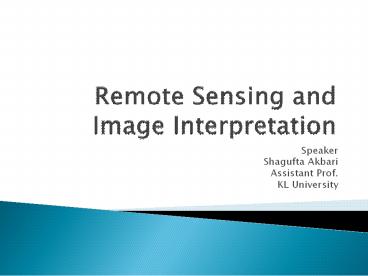Remote Sensing and Image Interpretation - PowerPoint PPT Presentation
Title:
Remote Sensing and Image Interpretation
Description:
Title: Remote Sensing and Image Interpretation Last modified by: Pallu Created Date: 8/16/2006 12:00:00 AM Document presentation format: On-screen Show (4:3) – PowerPoint PPT presentation
Number of Views:174
Avg rating:3.0/5.0
Title: Remote Sensing and Image Interpretation
1
Remote Sensing and Image Interpretation
- Speaker
- Shagufta Akbari
- Assistant Prof.
- KL University
2
contents
- Introduction
- Map as a model
- Spatial elements and terminology
- Classification of Maps
- Map Scale
- Spatial referencing system
- Computers in map production
- General softwares in map production
- Types of data products
3
Continued
- Image interpretation strategy
- Levels of interpretation keys
- Topography
- Types of Drainage pattern and Texture
- Erosion
- Process of image interpretation
- Basic elements of image interpretation
- Overview on visual image interpretation equipment
4
- Map as Model
- Representation of features of earth drawn to
scale - A map is a very powerful tool and maps are
typical reductions which are smaller than the
areas they portray
(Robinson et.al 1984)
5
Spatial elements and terminology
- Spatial objects in the real world can be thought
of as occurring in four easily identifiable types
namely, points, lines, areas and surfaces - Points, lines and areas can be represented by
using symbols to depict the real world. - Surfaces are represented by any combination of
these spatial entities. - In general, all the geographic surfaces are in
two tangible forms, namely, discrete and
continuous. - Trees, houses, road intersections and similar
items are discrete spatial features.
6
Classification of Maps
- On the basis of scale
- Small scale map
- Large scale map- urban plan map, transportation
and network map
7
Map Scale
- The ratio between the reduced depiction on the
map and the geographical features in the real
world is known as the Map Scale - Scale expressed in three ways
- Fractional scale-the method of representing this
type of scale is called representation fraction
method
8
- In India commonly used fractional map scales are
11,00,000,00 1250,000, 150,000 125,000 and
110,000 - Graphical Scale- A line printed on the map and
divided into units that are equivalent to some
distance - The measured ground distance appears directly on
the map in graphical representation - Verbal Scale- This is an expression in common
speech like an inch to a mile
9
Spatial referencing system
- To locate objects with respect to some reference
system - Methods of spatial referencing systems
- Geographic coordinate systems-
- Denoted by latitude and longitude
- Rectangular coordinate systems(RCS)
- Spatial data are in two-dimensional form
- Relative position- location of any point on the
earths surface w.r.t RCS - Non- coordinate systems
- Spatial reference with descriptive codes such as
postal codes which is numeric in nature
10
Computers in map production
- Advantages
- To make existing maps more at a quicker pace
- To make existing maps at a cheaper rate
- To make maps for specific user needs
- To make map production possible in situations
where skilled staff are unavailable - To allow experimentation with different graphical
representations of the same data
11
Continued
- To facilitate map making and updating when the
data are already in digital form - To minimize the use of the printed map as a data
store and thereby to minimize the effects of
classification and generalization on the quality
of the data - Introduction of automation can lead to a review
of the whole map making process , which can
also lead to savings and improvements
12
General softwares in map production
- Arc- GIS
- ARC- VIEW etc.
13
Types of data products
Depending on correction applied level of
processing
Note FCC are generated by combininig the data
contained in three spectral bands respectively.
The choice of band combinations can be determined
depending upon application
14
Image interpretation strategy
- Visual image interpretation Process of
indentifying what we see on the images and
communicate the information obtained from these
images to others for evaluating its significance - Includes relative locations and extents
- Use of data products like Satellite single band
imageries, FCC for performing image
interpretations to extract thematic information
for subsequent input to GIS
15
Levels of interpretation keys
- Interpretation Keys Criterion for identification
of an object with interpretation elements
16
Basic elements of image interpretation
17
Size
- Size of objects in an image is a function of
scale - Proper photo scale selected depending on the
purpose of interpretation - Most commonly measured parameters- length,
width, perimeter, area and occasionally volume
18
Shape
- Shape of an object is described as the geometric
form represented form represented on an image - Regular shapes are signs of man-made objects
- Irregular shapes with no distinct geometrical
pattern are signs of a natural environment
19
Shadow
- Shadow usually a visual obstacle for image
interpretation - Gives height information about towers, tall
buildings
H object
S Shadow
20
Tone
- Band of EM spectrum recorded by RS system may be
displayed in shades of grey ranging from black to
white - Tone-
- continuous grey scale varying from white to black
- It refers to relative brightness or colour of
objects in an image - Note- Humans differentiate 40- 50 individual
shades of grey RS image
21
- Colour
- more convenient for the identification of object
details - Texture
- Characteristics placement arrangement of
repetitions of tone or colour in an image - Visual impression of roughness or smoothness of
an image region































